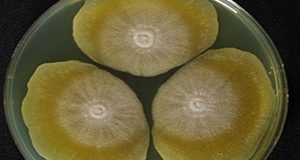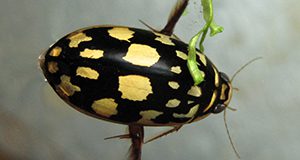Ambrosiodmus minor is an invasive ambrosia beetle in the southeastern United States, including Florida. It is considered of low importance because evident economic or ecological impacts have not been observed. However, it is associated with a unique ambrosia fungus, Flavodon subulatus, which causes rapid wood rot. Wood decay caused by this association between Ambrosiodmus and Flavodon is increasing in dead trees across the introduced range, especially in Florida. This 4-page fact sheet written by Demian F. Gomez and Jiri Hulcr and published by the UF/IFAS School of Forest Resources and Conservation offers guidance in identification of the pest, the symptoms of an infestation, and explanation of the insect’s biology. In addition, we provide an updated overview of contemporary management and monitoring of the species.
https://edis.ifas.ufl.edu/fr434
Tag: Jiri Hulcr
Red Heart Disease in Pines caused by Porodaedalea (Phellinus) pini in Florida

All pine species in Florida are susceptible to red heart disease. The disease can decrease timber value and weaken trees, making them threats to people and property. In forests, however, the same disease can be beneficial to cavity-nesting animals like red-cockaded woodpeckers. This 3-page fact sheet written by Yin-Tse Huang, Jeffrey Eickwort, and Jiri Hulcr and published by the UF/IFAS School of Forest Resources and Conservation describes the disease and provides some tips to manage it in areas where it could cause problems for people.
http://edis.ifas.ufl.edu/fr425
The invasive shot hole borers Euwallacea fornicatus, E. kuroshio, and E. perbrevis (Coleoptera: Curculionidae: Scolytinae)
Invasive species, those that are nonnative and cause economic damage, are one of the main threats to ecosystems around the world. Ambrosia beetles are some of the most common invasive insects. Currently, severe economic impacts have been increasingly reported for all the invasive shot hole borers in South Africa, California, Israel, and throughout Asia. This 7-page fact sheet written by Demian F. Gomez, Jiri Hulcr, and Daniel Carrillo and published by the School of Forest Resources and Conservation describes shot hole borers and their biology and hosts and lists some strategies for prevention and control of these pests.
http://edis.ifas.ufl.edu/fr422
The Southern Pine Beetle Dendroctonus frontalis (Coleoptera: Curculionidae: Scolytinae)
The southern pine beetle, Dendroctonus frontalis Zimmermann, is the most destructive insect pest of pine in the southern United States. This 8-page fact sheet written by Demian F. Gomez and Jiri Hulcr and published by the UF/IFAS Department of Entomology and Nematology describes the beetle and includes advice on how to monitor for them and strategies for their prevention and control.
http://edis.ifas.ufl.edu/in333
Geosmithia Species in Florida: Common Fungal Symbionts of Wood-Boring Bark Beetles
Geosmithia are fungi associated with wood-boring bark beetles. Most Geosmithia species do no harm to host trees, but the canker-causing Geosmithia morbida and its beetle vector, the walnut twig beetle, cause the disease complex known as thousand cankers disease on walnut trees. Continuous surveys in Florida have found neither Geosmithia morbida nor its beetle vector in the state, but many native Geosmithia species have been recovered. These native species look similar to the pathogenic fungus but are harmless to their plant hosts. This 4-page fact sheet written by Yin-Tse Huang and Jiri Hulcr and published by the UF/IFAS School of Forest Resources and Conservation provides basic guidelines to sample Geosmithia species in the field and information for distinguishing the plant pathogenic Geosmithia morbida from other Geosmithia species.
http://edis.ifas.ufl.edu/fr412
Predaceous Diving Beetles as Pets and the Self-Cleaning Aquarium
Meet a new, attractive, easy-to-keep, local, non-endangered, aquatic pet: the diving beetle! Predaceous diving beetles are aesthetically pleasing yet still rare in US aquariums (though common in countries like Japan), which makes them a fun, new, unusual pet. This 5-page fact sheet written by Craig Bateman and Jiri Hulcr and published by the School of Forest Resources and Conservation provides information about the aquatic beetles, including how to catch and maintain them. Learn how you can befriend these sprightly little insect pals and allow them to bring to your home a mysterious green and quiet world, beautiful silver air bubbles and bronze iridescence, and exciting shows of feeding frenzy. And if you have to part with them, you can safely release the native species into the wild, because they are a part of our Florida natural landscape.
edis.ifas.ufl.edu/fr398
My Pine Is Under Attack: What Should I Do? A Primarily Insect-Based Decision-Support Guide for Pine Death Management

This guide is intended to help tree owners and Extension personnel in Florida and the adjacent southeastern region make decisions about backyard pine trees that display signs of attack by wood borers. The three-page pictorial guide written by Jiri Hulcr and published by the School of Forest Resources and Conservation will help determine whether beetles have attacked a pine tree, how far along the attack has progressed, and what to do about it. There are many sources of pine stress other than insects, so for complete advice, please contact your county Extension agent or post your question at the Tree Health Diagnostics Forum at the University of Florida website: http://www.sfrc.ufl.edu/treehealth.
http://edis.ifas.ufl.edu/fr399
Tea Shot-Hole Borer Euwallacea fornicates (Eichhoff, 1868) (Insecta: Coleoptera: Curculionidae: Scolytinae)

The tea shot-hole borer is an Asian ambrosia beetle introduced to Florida in the early 2000s. In Florida it does not have any known economic impact, but it is a serious pest of tea around the world and is one of the few ambrosia beetles that can infest healthy plants. The tea shot hole borer has a symbiotic relationships with the ambrosia fungus Fusarium ambrosium (Gadd & Loos), which is also a weak plant pathogen. This 4-page fact sheet includes diagnosis section with guidance for avoiding misidentification. Written by You Li, Andrea Lucky, and Jiri Hulcr, and published by the UF Department of Entomology and Nematology, June 2015.
http://edis.ifas.ufl.edu/in1090
Black Turpentine Beetle, Dendroctonus terebrans (Olivier) (Insecta: Coleoptera: Curculionidae: Scolytinae)
 Black turpentine beetles bore into the inner bark of stressed or injured pines, where they breed and feed on phloem tissue. Adults are strongly attracted to volatile pine odors and readily breed in fresh stumps. In typical forests, infestations do not exhibit the rapid and devastating expansion characteristic of the closely related southern pine beetle, but in stands where stress conditions are frequent or persistent, black turpentine beetle can become a chronic pest and cause significant mortality over an extended period of time. Historically, black turpentine beetle has been a major pest of pines wounded or treated with herbicides in naval stores production. During the 1950s, black turpentine beetle damaged 37 million board feet of timber and contributed to the financial collapse of turpentine farms. This 5-page fact sheet was written by Albert E. Mayfield, John L. Foltz and Jiri Hulcr, and published by the UF Department of Entomology and Nematology, June 2015. (Photo credit Adam Black and Jiri Hulcr, UF/IFAS)
Black turpentine beetles bore into the inner bark of stressed or injured pines, where they breed and feed on phloem tissue. Adults are strongly attracted to volatile pine odors and readily breed in fresh stumps. In typical forests, infestations do not exhibit the rapid and devastating expansion characteristic of the closely related southern pine beetle, but in stands where stress conditions are frequent or persistent, black turpentine beetle can become a chronic pest and cause significant mortality over an extended period of time. Historically, black turpentine beetle has been a major pest of pines wounded or treated with herbicides in naval stores production. During the 1950s, black turpentine beetle damaged 37 million board feet of timber and contributed to the financial collapse of turpentine farms. This 5-page fact sheet was written by Albert E. Mayfield, John L. Foltz and Jiri Hulcr, and published by the UF Department of Entomology and Nematology, June 2015. (Photo credit Adam Black and Jiri Hulcr, UF/IFAS)
http://edis.ifas.ufl.edu/in636
An ambrosia beetle Xyleborus affinis Eichhoff, 1868 (Insecta: Coleoptera: Curculionidae: Scolytinae)
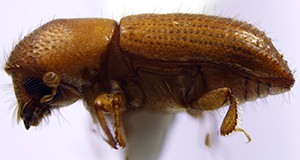 Xyleborus affinis is one of the most widespread and common ambrosia beetles in the world. It is also very common in Florida. Like other ambrosia beetles, it bores tunnels into the xylem of weakened, cut or injured trees and farms gardens of symbiotic fungus for food. Females lay eggs in the fungus-lined galleries and larvae feed exclusively on the fungi. Recent studies have shown that Xyleborus affinis can vector the fungus responsible for laurel wilt disease, which is lethal to numerous species of trees in the Lauraceae family. This 5-page fact sheet was written by Lanette Sobel, Andrea Lucky, and Jiri Hulcr, and published by the UF Department of Entomology and Nematology, June 2015. (Photo credit: Juri Hulcr, UF/IFAS)
Xyleborus affinis is one of the most widespread and common ambrosia beetles in the world. It is also very common in Florida. Like other ambrosia beetles, it bores tunnels into the xylem of weakened, cut or injured trees and farms gardens of symbiotic fungus for food. Females lay eggs in the fungus-lined galleries and larvae feed exclusively on the fungi. Recent studies have shown that Xyleborus affinis can vector the fungus responsible for laurel wilt disease, which is lethal to numerous species of trees in the Lauraceae family. This 5-page fact sheet was written by Lanette Sobel, Andrea Lucky, and Jiri Hulcr, and published by the UF Department of Entomology and Nematology, June 2015. (Photo credit: Juri Hulcr, UF/IFAS)
http://edis.ifas.ufl.edu/in1094
Asian Horntail Eriotremex formosanus (Matsumura) (Insecta: Hymenoptera: Symphyta: Siricidae: Tremicinae)
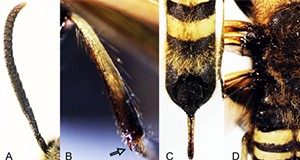
Since it was introduced to North America, the Asian woodwasp has become the most common wood wasp in Florida. It is not considered an economically important pest because it only attacks dying or dead trees, but the species may someday prove to be a pest and its ecological impacts in North American forests remain unknown. This 4-page fact sheet was written by You Li and Jiri Hulcr, and published by the UF Department of Entomology and Nematology, June 2015. (Photo credit: You Li, UF/IFAS)
http://edis.ifas.ufl.edu/in1095
A guide to Florida's common bark and ambrosia beetles
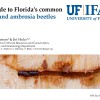 This 36-page guide provides an introduction to the biology and identification of Florida’s bark and ambrosia beetles. Written by Craig Bateman and Jiri Hulcr, and published by the UF Department of School of Forest Resources and Conservation, September 2014.
This 36-page guide provides an introduction to the biology and identification of Florida’s bark and ambrosia beetles. Written by Craig Bateman and Jiri Hulcr, and published by the UF Department of School of Forest Resources and Conservation, September 2014.
http://edis.ifas.ufl.edu/fr389
Why is your cup of coffee so expensive? Because of a tiny bark beetle!
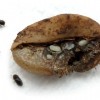 Sometimes an insect pest attacking crops in places as far away as Indonesia or Ethiopia can be very important to us here in Florida. One such insect is the coffee berry borer, Hypothenemus hampei Ferrari (Coleoptera: Curculionidae: Scolytinae), a tiny (1.5 mm) bark beetle that originated in the highlands of central Africa. It would probably remain one of the many inconspicuous little beetles in the tropics, if not for the choice of its host: seeds of several Coffea species. This 3-page fact sheet was written by Jiri Hulcr, and published by the UF Department of School of Forest Resources and Conservation, October 2013.
Sometimes an insect pest attacking crops in places as far away as Indonesia or Ethiopia can be very important to us here in Florida. One such insect is the coffee berry borer, Hypothenemus hampei Ferrari (Coleoptera: Curculionidae: Scolytinae), a tiny (1.5 mm) bark beetle that originated in the highlands of central Africa. It would probably remain one of the many inconspicuous little beetles in the tropics, if not for the choice of its host: seeds of several Coffea species. This 3-page fact sheet was written by Jiri Hulcr, and published by the UF Department of School of Forest Resources and Conservation, October 2013.
http://edis.ifas.ufl.edu/fr382
Redbay Ambrosia Beetle Xyleborus glabratus Eichhoff (Insecta: Coleoptera: Curculionidae: Scolytinae) (EENY491/IN886)
Ambrosia beetles are wood-degrading insects that live in nutritional symbiosis with ambrosia fungi. Usually we consider ambrosia beetles beneficial because they accelerate the decay of dead trees, which is important for nutrient cycling in healthy forests. However, the redbay ambrosia beetle and its fungal symbiont transmit the causal pathogen of laurel wilt disease among plants in the Laurel family (Lauraceae). They are considered a “very high risk” invasive disease pest complex having potential equal to that of Dutch elm disease or chestnut blight. Laurel wilt is a relatively new disease and much is still unknown about how it will impact the flora of North America. This 7-page fact sheet highlights what we do know about this important new pest. Written by Rajinder Mann, Jiri Hulcr, Jorge Peña, and Lukasz Stelinski, and published by the UF Department of Entomology and Nematology, May 2011.
http://edis.ifas.ufl.edu/in886



